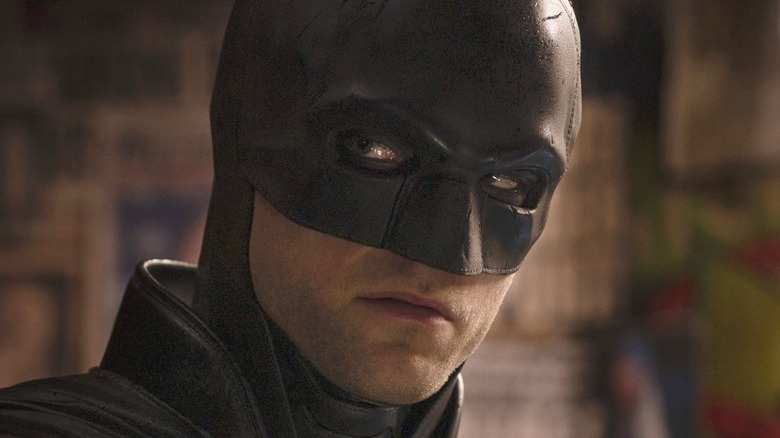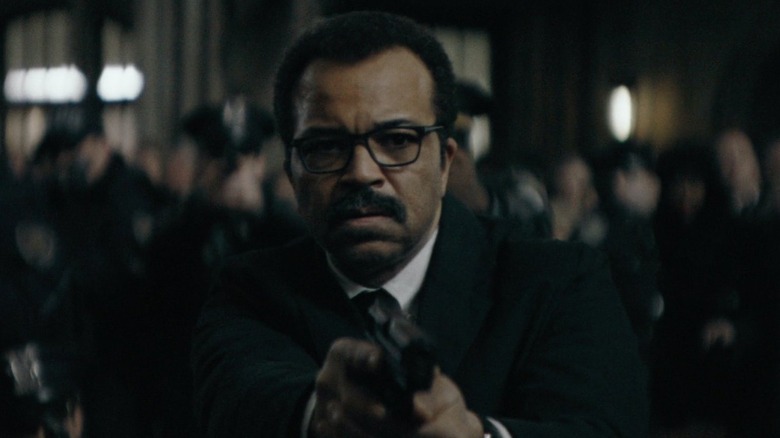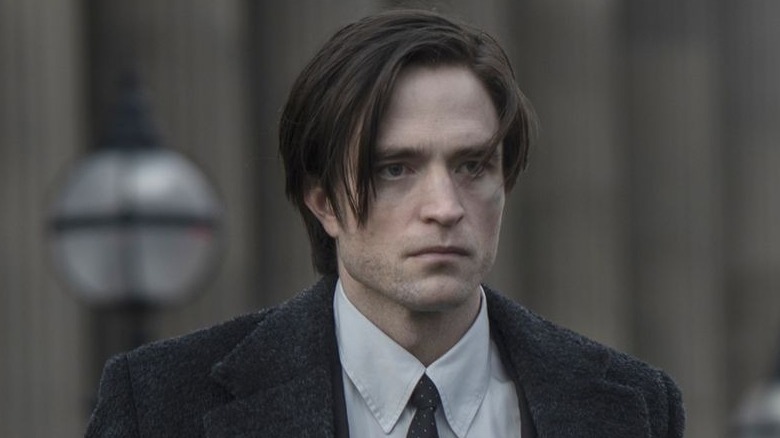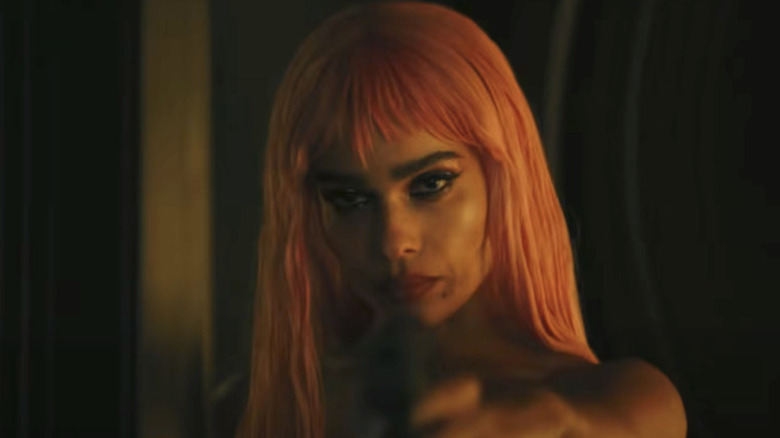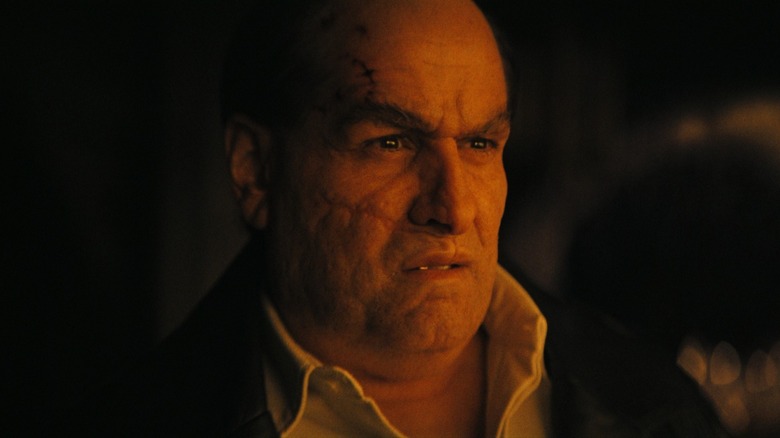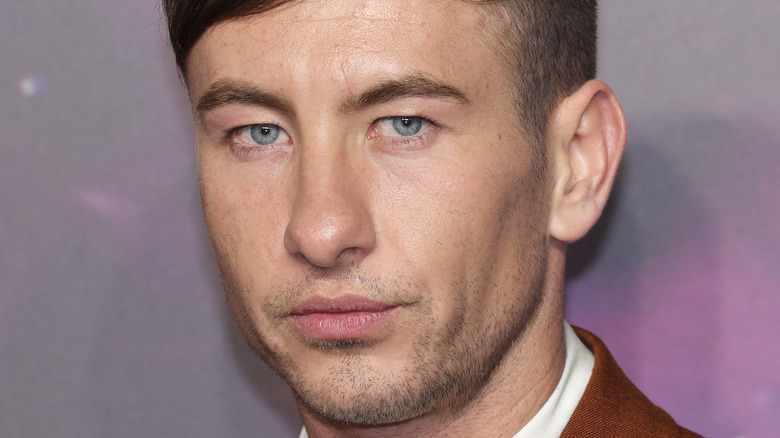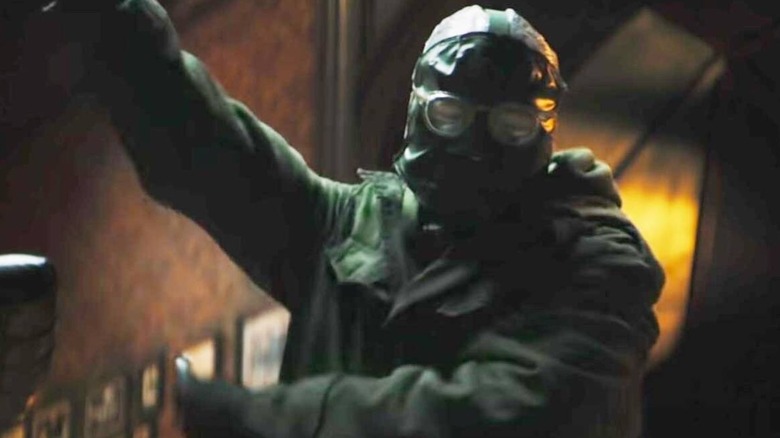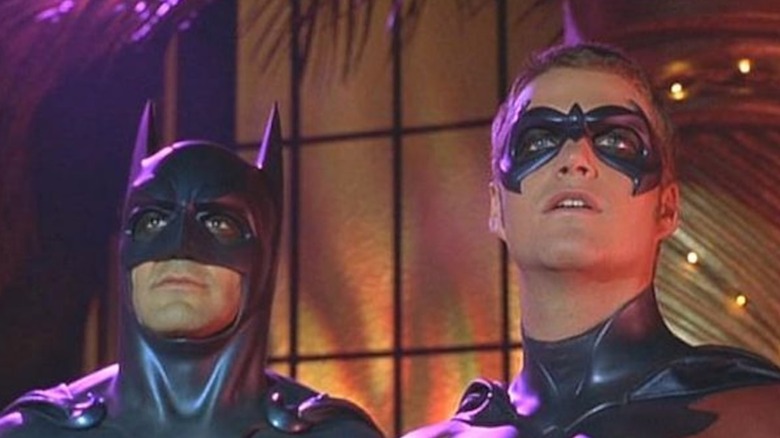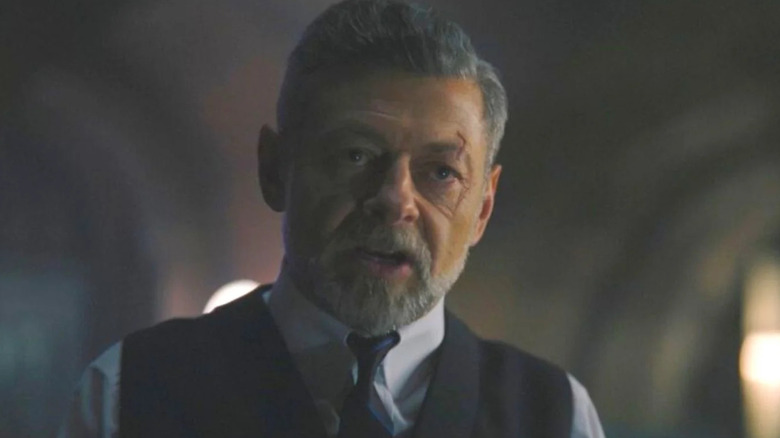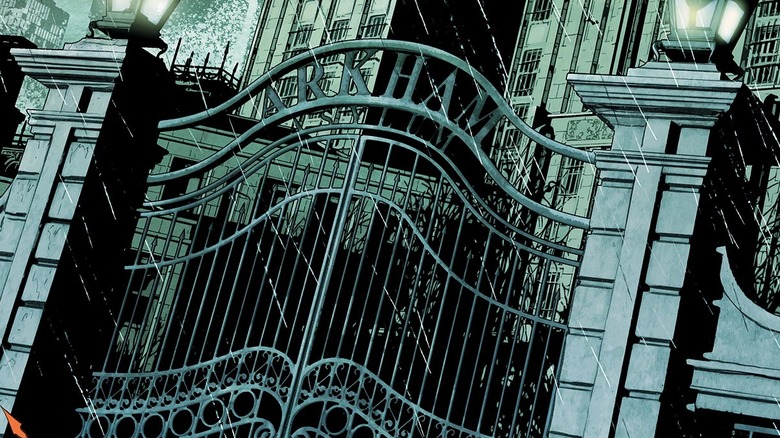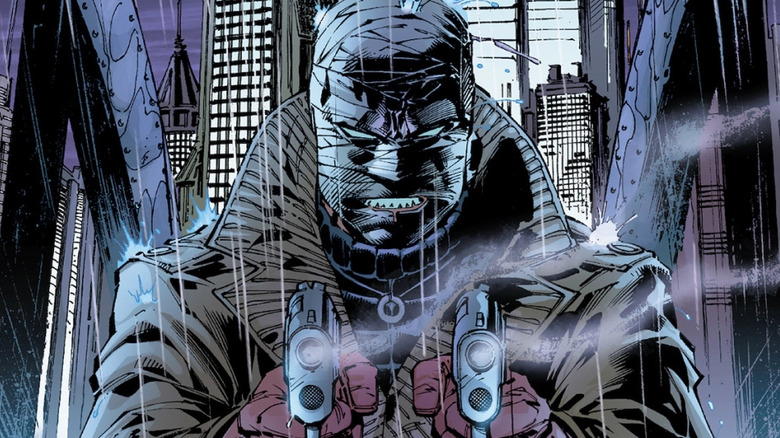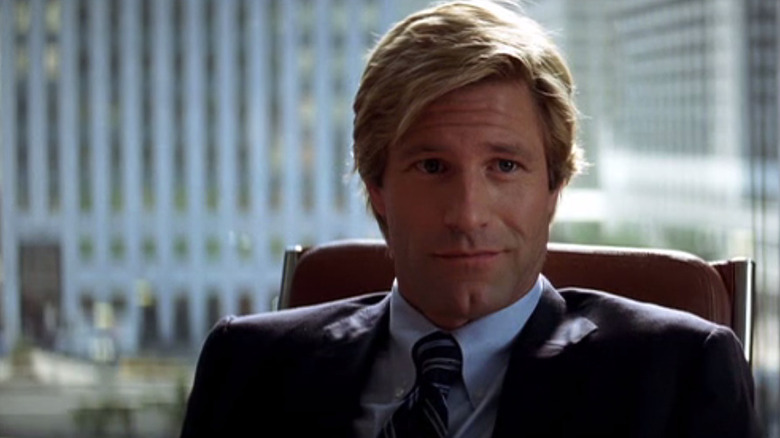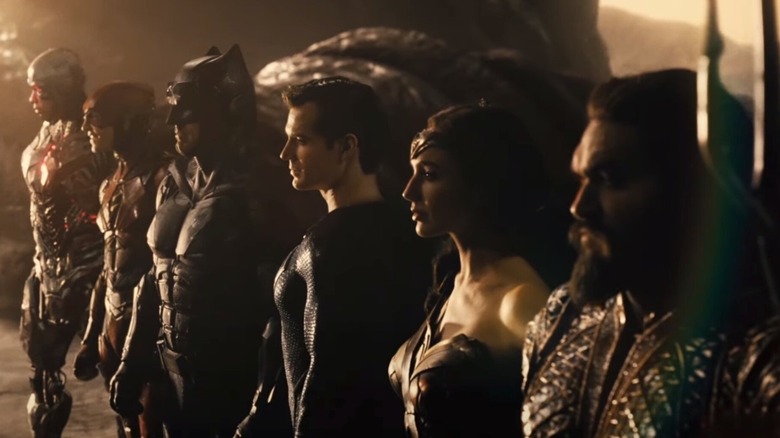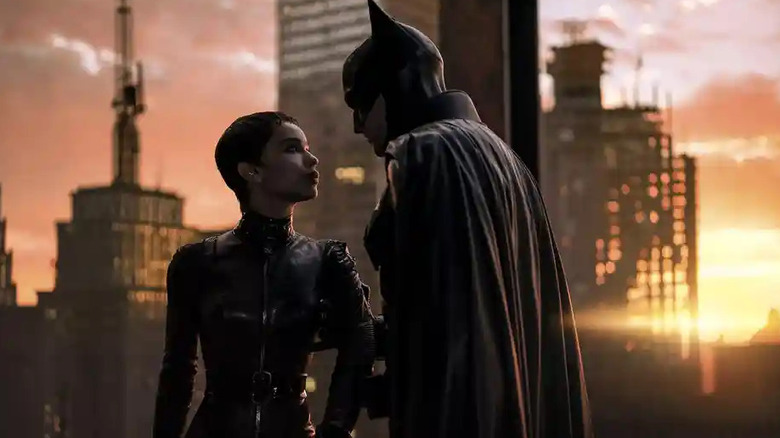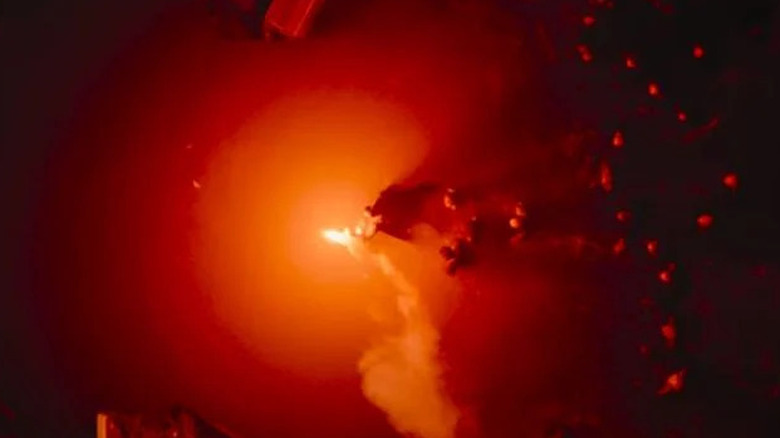Storylines We Want To See In The Batman 2
This article contains spoilers for "The Batman."
Matt Reeves' "The Batman" has delivered the Dark Knight's first live-action solo film since the end of the Christopher Nolan trilogy, and it's already being heralded as one of the best yet. Robert Pattinson, Zoë Kravitz, Paul Dano, Jeffrey Wright, Andy Serkis, and Colin Farrell have all earned high praise for their performances. The film has also been lauded for its striking sense of style, blending bold cinematography and a powerful musical score to establish tension across all three hours.
Given the many issues and criticisms that plagued the DCEU in general and its version of Batman, it's great to see how widely popular Reeves' film has already become. "The Batman" incorporates many of the classic qualities fans associate with the Caped Crusader — such as his hatred of guns and strict no-killing policy — while also bringing a tone and aesthetic that haven't really been seen in the previous movies. The heavy focus on noir-style detective storytelling and Pattinson's unique portrayal of a young Bruce Wayne have made the new film distinct without changing the things that fans have come to love about the character.
With such a big success on their hands, there's no doubt that Reeves, Pattinson, and the rest will be back soon with "The Batman 2." The first film sets up some interesting plotlines that could become central in a second film, and there are a lot of other exciting narrative possibilities based on the comics. Here are some big storylines that we'd love to see in "The Batman 2."
Jim Gordon becoming Police Commissioner
Jeffrey Wright's Jim Gordon is one of the best parts of "The Batman" — a grizzled version of the GCPD cop who really drives home both the dire state of Gotham City and the film's basis in classic Hollywood noir. Gordon feels very much like a peer to Batman in Reeves' film, which makes much of the movie a kind of buddy cop mystery as they attempt to unravel the Riddler's various puzzles. As the story develops, Gordon also realizes that he's one of the few honest cops left in Gotham — a revelation that shakes his faith in the institution but doesn't stop him from fighting to protect the innocent.
It's no secret that Gordon serves as the Gotham City Police Commissioner for the majority of the "Batman" comics. Gary Oldman's version of the character eventually rises to that rank in the "Dark Knight" trilogy, and it seems likely that Wright's iteration will follow the same path. He gets bumped up the chain of command early on in "The Batman" after Commissioner Pete Savage is murdered by the Riddler, but he's still far from running the whole show.
It would be interesting to see Gordon rise to the rank of commissioner in "The Batman 2," but it also might be a tough leap for the character to make. His close relationship with Batman seems to have made him more enemies than friends, which means many within the organization might prefer to see Gordon buried than promoted.
Bruce Wayne stepping back into the spotlight
One of the more unique aspects of Robert Pattinson's Bruce Wayne is that he's far less accustomed to the celebrity limelight than many past editions of the character. Traditionally, Bruce has acted as a prominent playboy of Gotham high society — an act meant to draw attention away from his nocturnal activities fighting crime. In "The Batman," however, Bruce is shown to be a recluse. His Dark Knight crusade has fully consumed him, keeping him out of the public eye and uninterested in running the family business.
This portrayal of Bruce Wayne makes sense within the story of "The Batman," but there are hints that the prince of Gotham could return to his more flamboyant comic book ways in the sequel. By the end of the film, Bruce recognizes that he needs to be a symbol of hope just as much as he needs to be a symbol of fear, and that he'll never be able to save the city if he only focuses on its darkness. He's also encouraged by Gotham's mayor-elect Bella Reál (Jayme Lawson) to engage more actively in philanthropy and use his vast resources for the public good.
The Wayne family name is tarnished by the end of "The Batman," and it would be interesting to see Bruce try to redeem it in the next movie. Returning to public life could help him avoid scrutiny, and it would allow him to pair his actions as Bruce Wayne with his new heroic intentions as Batman.
Catwoman's continuing adventures
Over the course of "The Batman," the eponymous vigilante develops a close alliance and a tenuous romance with Selina Kyle, aka Catwoman. She helps him stop the Riddler and his associates and plays an instrumental role in saving Gotham from total destruction. However, the darkness of the city proves to be too much for her to bear, and she ends up leaving the city at the end of the film in search of more peaceful surroundings.
Given that Kravitz's Catwoman has been called one of the best parts of the whole movie, it would be a shame if she didn't return in "The Batman 2." Fortunately, Reeves' film has left a few options open for her return. When she leaves Gotham, she tells Bruce that she might go to Blüdhaven — a nearby city perhaps most famous in the comics for being the home of Nightwing. Seeing her in a live-action version of Blüdhaven in the next movie could be fun, and it would give her an opportunity to stretch as a character outside of her relationship with Batman. Of course, it would also be fun to see her return to Gotham, and there are plenty of ways a sequel could convincingly bring her back.
Honestly though, the best option might just be to give Kravitz her own "Catwoman" solo film. Her performance in "The Batman" is just that good.
The Penguin's rise to power
Colin Farrell's Penguin fills a unique role in "The Batman," being both a third-tier villain and a bizarre kind of comic relief character. While he certainly has sinister moments, he mostly feels like a stooge — a cartoonish foil to the more serious threats of Riddler and Carmine Falcone. Farrell does a great job keeping the Penguin compelling within those limits, however, and as one of the most prolific "Batman" villains ever, he could be primed for an even bigger arc in "The Batman 2."
Think about it: By the end of Reeves' film, Falcone is dead. The status quo of Gotham's underworld is shattered, and as Catwoman herself says, there will likely be a violent power grab. The Penguin may do some light jail time for his involvement in the events of the film, but in the corrupt world of Gotham City, it seems unlikely that he'll be locked up for long. Once he gets out, he stands as the perfect person to seize control of Falcone's old empire, having already been a huge part of it for years.
The story of Barry Keoghan's Joker
In one of its final scenes, "The Batman" teases the greatest of all the Dark Knight's villains — a new version of the Joker played by Barry Keoghan. The so-called Clown Prince of Crime has featured in a number of live-action projects in recent years, with actors like Heath Ledger, Joaquin Phoenix, Cameron Monaghan, and Jared Leto all taking swings at the character. That history puts a lot of pressure on Keoghan and director Matt Reeves to deliver a Joker who feels fresh and distinct — a tough challenge, but one that Reeves and his team seem more than up to if it ever comes to pass.
Even though it's brief, the Joker's cameo at the end of "The Batman" has already revealed some interesting details about this new version of the character. He's already locked up in Arkham Asylum, but it isn't clear why. Has he already donned the infamous Joker face paint and persona, or was he institutionalized for some other reason? Has his origin story already happened, or is his meeting with the Riddler what truly sets him off? Since Batman has already been working in Gotham for a while when the movie starts, it's possible that he's already had a run-in with the Joker — which Reeves has apparently already confirmed. There's a lot of rich potential for the Joker in "The Batman 2" or beyond, but it will still be a tall task to measure up to the best Jokers ever.
The return of the Riddler
The Riddler may be defeated by the end of "The Batman," but he's still very much alive and therefore very much a threat. Fans of the comics will know that Arkham Asylum is far from a perfect prison, with breakouts being a common starting point for many "Batman" stories. Paul Dano's performance has been highly praised, so it would make sense to bring the Riddler back in one way or another.
After becoming "friends" with the Joker at the end of "The Batman," the most obvious role for Riddler down the line might be as his right-hand man. In the comics, villains have often teamed up against the Dark Knight in an effort to bring him down for good, and it would be fun to see two of the hero's most famous foes join forces on the big screen. Reeves has already done a great job of establishing the "Batman" rogues' gallery by fitting Penguin, Riddler, and Catwoman into different roles of varying narrative importance, and with that same structure in place in "The Batman 2," there could be room for even more baddies.
A less likely but equally compelling possibility is that the Riddler could become a tenuous ally to the Caped Crusader in the next film. He spends much of "The Batman" admiring the Dark Knight, and his love of puzzles might compel him to help out if Bruce were forced to ask him for advice down the line.
The return of Robin
It's been a long time since a live-action "Batman" movie featured the character's classic sidekick Robin, probably because the last real attempt went so poorly. Yes, there was a half-hearted homage in "The Dark Knight Rises" via Joseph Gordon Levitt's John Blake character, but no one's worn the green and red on the big screen since Chris O'Donnell. "The Batman 2" could finally change that.
At first glance, it might not seem like the Boy Wonder would fit aesthetically within Reeve's dark and gritty rendition of Gotham City. However, with a few slight tonal tweaks in line with Pattinson's Batman, Robin could still work quite well. Introducing him would allow the film to explore another aspect of Gotham's descent — the impact of crime and economic hardship on the city's youth. The first movie has already started that conversation with its Riddler backstory — a brutal childhood spent in one of Gotham's neglected orphanages.
Maybe the conflict with the Riddler pushes Bruce Wayne to take a greater interest in Gotham's young innocents. Maybe he fixes up the old orphanage his parents built and meets a young man named Dick Grayson. Or maybe "The Batman 2" could introduce Robin some other way. Regardless, he'd be a great addition to the world Reeves has built, opening up new aspects of Bruce's own character development and marking what could be a triumphant return for the most famous superhero sidekick of all time.
Alfred's backstory explained
Alfred Pennyworth is far more than a wizened butler, as fans of the "Batman" comics will know. Though it has gone through various incarnations over the years, Alfred's backstory almost always involves extended military service in the British special forces — training that aids him endlessly in his role as Batman's right-hand man. While past film incarnations of Alfred have hinted at this complicated history, they've rarely tapped into it in any major way. That stays true with Andy Serkis' version of Alfred in "The Batman," but there are a few details that suggest he could take on a larger role in the sequel.
For starters, Alfred says explicitly in "The Batman" that he taught Bruce how to fight — a notably divergence from the lore of the Christopher Nolan films. That direct connection to Batman's origins could be enough to prompt a flashback in the coming films, or at least a bit more exposition. Additionally, the mere casting of Serkis in the role of Alfred indicates that the character could take on a bit more action going forward. Compared to past actors like Michael Caine and Jeremy Irons, Serkis's Alfred is relatively young and spry. That choice fits with Pattinson's younger Bruce Wayne, but it also opens the door for more of an active role for Alfred going forward.
We don't need him to start beating up bad guys like he's the main character (there's a whole separate show for that), but a bit more backstory would be great to see.
More time in Arkham Asylum
"The Batman" assembles an impressive rogues' gallery by the end of its three-hour runtime — a cast of villains and antiheroes that includes Catwoman, the Riddler, the Penguin, Carmine Falcone, and the Joker. Now that a number of them are locked up in Arkham State Hospital, "The Batman 2" could begin exploring the depths of that institution and the other characters who dwell there.
One of the revelations the Riddler releases during his crusade is that the Waynes and the Arkhams — Gotham's founding families — both exercised corrupt practices and abuses of power throughout the city's history. "The Batman" focuses primarily on the Wayne side of that checkered past, since it pertains directly to the Dark Knight himself. That leaves a lot hinted at, but largely unresolved, regarding the Arkhams' own role in Gotham's downfall. Under what circumstances was Arkham Asylum constructed? What goes on behind its high walls? What are its connections to the city's corrupt politicians and police officers? These are all questions that could become central to the story of "The Batman 2," bringing new antagonists from within the depths of Arkham and adding dark new details to the city's complex past.
Batman vs. Hush
In his pursuit of the Riddler, Bruce Wayne discovers that his parents weren't exactly who he thought they were. One of the conspiracy videos leaked to the public in "The Batman" explains that his mother Martha struggled with mental illness throughout her life, and that Bruce's father Thomas Wayne went to some unscrupulous lengths to keep that information a secret. The Riddler mentions a journalist named Edward Elliot who was determined to publish a story on this secret history — a man who was killed by Carmine Falcone after Thomas asked the mobster to intervene.
The name Edward Elliot is curiously evocative of Tommy Elliot — a character from the "Batman" comics who becomes the dangerous villain known as Hush. The parallels are only strengthened by the fact that Thomas Wayne tried to keep Edward Elliot quiet by bribing him with so-called "hush money." Matt Reeves himself has named Hush as one of the main villains he'd like to bring to the big screen (via Twitter Movies), so it seems highly likely that all these allusions in "The Batman" are intentionally pointing to the character's big screen debut.
Hush would be a great fit with the specific version of Gotham City constructed in "The Batman," and it would also just be nice to see a new villain in a prominent role. Past films in the franchise have repeatedly rehashed big names like the Riddler, the Joker, and the Penguin, so someone different would be a breath of fresh air.
Gotham District Attorney Harvey Dent
One of the victims of the Riddler's violent campaign against corruption is Gotham City District Attorney Gil Colson, who dies in brutal fashion with the whole city watching. Though it's a dark way to inherit the position, someone will have to step up and take his place in "The Batman 2," and it could be Gotham's most famous DA, Harvey Dent.
More famous as his villainous alter ego Two-Face, Dent was last portrayed on the big screen by Aaron Eckhart in "The Dark Knight." Eckhart's stellar performance is a tough one to follow up, which may be part of why Two-Face hasn't returned to the "Batman" movies since. However, enough time has passed now, and Reeves' particular version of Gotham seems primed for the moral duality of Harvey Dent.
Part of what makes the character such an interesting choice is that he can be played in a number of ways. "The Batman 2" could solely feature a young and idealistic Dent, saving his fall to the dark side for the final film in a potential trilogy. Alternatively, he could become a late-stage villain as he does in "The Dark Knight," with his transformation acting as one of the sequel's big turning points. There are a lot of options when working with the Harvey Dent character, and it would be fun to see Reeves' universe put its own spin on this classic villain.
A larger DC continuity
At this point, it's well documented that "The Batman" isn't part of the DCEU. It's a completely separate canon with its own rules, and that separation seems to have worked out pretty well so far. It's possible that Pattinson's Dark Knight could be referenced in "The Flash" since that film is already playing with alternate DC timelines and universes, but it's highly unlikely that the two will intersect in any meaningful or permanent way.
And yet, it would be kind of fun to see "The Batman 2" embrace a larger DC continuity. It might be a little discordant to see Superman flying through the sky in his red and blue tights, but that doesn't mean there isn't room for non-"Batman" characters and plotlines to play into future films. Batman is a character who works fine on his own, as many of his best cinematic outings have proven. However, some of his best moments in the comics and DC's animated properties have come through his interactions with other heroes from outside of Gotham. He's so different from the brightly colored characters who make up most of the DC universe, and that's a big part of why he's always been so popular. Batman thrives when he's contrasted with heroes like Superman because they reveal what makes him so unique.
Do we need a new "Justice League" film set in the universe of "The Batman"? No. But it could be interesting if the sequels broaden Bruce's world just a bit.
Real progress for Gotham City
Perhaps more than any of the Dark Knight's past films, "The Batman" is truly a story about Gotham. From the production design and the cinematography to the ever-present musical score, the film constantly reminds viewers just how grim things have become in the city. The story ends with hope that real change may come, but that hope is built in the wreckage of near-complete annihilation — much of the city lying in ruin after the Riddler's brutal attacks.
Obviously, Gotham's problems won't be solved overnight, but "The Batman 2" would do well to show at least a bit of progress and healing. Yes, Carmine Falcone's death will likely lead to a mob war, and yes, the public's faith in the city's institutions has been shaken to its core. But that's just the thing — Gotham truly feels like it hits rock-bottom in "The Batman," and it would be tough to keep it there in the sequel without retreading familiar plot points. If the story is to continue moving forward in a meaningful way, Gotham has to start healing in "The Batman 2." Fortunately, it now has a true hero to help it along the way.
Batman becoming a true hero
One of the best things about "The Batman" is that it gives the eponymous hero a real character arc, something that many past film adaptations have lacked. At the start of the story, Bruce Wayne is an angst-ridden recluse with a desire for vengeance and little else. He believes that striking fear into the criminals of Gotham will ultimately save the city, but it ends up doing the opposite. In the final battle against the Riddler's cronies, Batman realizes that he unintentionally inspired both them and the Riddler himself. It turns out that wanton vigilante justice isn't actually all that heroic.
The cool part is that Bruce actually changes as a result of this revelation. His final heroic moment isn't beating some bad guy to a pulp, but rather saving a group of innocent civilians. The scene of him leading the way out of Gotham Square Garden with a flare in hand is gorgeous, and it does a great job of marking the progress Bruce has made towards actual heroism. Hopefully, "The Batman 2" will continue that arc, turning the Bat-Signal into a beacon of hope instead of just a sign of fear. It's fun to see a young Bruce Wayne grappling with the responsibility of being a symbol, and so far, Pattinson and Reeves are doing a great job of bringing that struggle to life.
